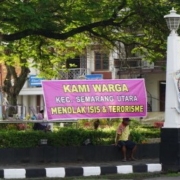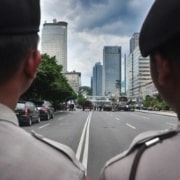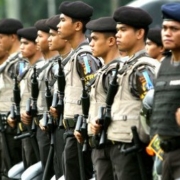
Police guard the Surabaya Central Pentecostal Church (GPPS) in Surabaya, East Java, one of three sites targeted by suicide bombers on 13 May 2018. Photo by Moch Asim for Antara.
A series of attacks across Indonesia in the first weeks of May resulted in the deaths of eight police officers, 12 civilians and 30 militants. The violence was the deadliest spate of terrorist activity since the 2005 Bali bombings, which killed 23 people, including the three perpetrators.
These incidents reflect global trends in Islamist militancy, in particular, promotion of the mobilisation of women and children in attacks by the Islamic State group (IS, also known as ISIS/ISIL). They also bear the hallmarks of home-grown terrorist movements.
The first attack took place on 8 May, when a group of 156 terrorism detainees launched a riot at a detention facility at the National Police Mobile Brigade (Brimob) headquarters south of Jakarta. The men took several police officers hostage, killing five by the time the riot was eventually quelled the following morning.
Sidney Jones, the director of the Institute for Policy Analysis of Conflict (IPAC), said the detainees were “almost all pro-ISIS” in an interview with the New York Times on 9 May. The group claimed responsibility for the attack in a statement issued by its official news agency, Amaq, and supporters shared images of the inmates hoisting a black IS flag, brandishing firearms and holding hostages.
Despite the claim of responsibility, the extent of the group’s real involvement in planning the attack remains unclear. According to an IPAC report from December 2016, the Brimob facility was perpetually overcrowded, understaffed and prone to small-scale outbreaks of violence. In fact, a smaller riot broke out as recently as November 2017.
This is not to deny the possibility of IS involvement but it does highlight the underlying structural problems with Indonesia’s prison system and the potential for unpremeditated, sporadic flare-ups or opportunistic attacks coordinated by a local group inspired by IS.
Following the prison riot, a suspected Islamist militant stabbed and killed a police officer on 10 May. The officer was on duty outside a hospital in Depok, West Java, near the Brimob facility. Other police officers killed the suspect before he could be interrogated about his motives.
Three days later, a family of six attacked three churches in Surabaya, East Java, killing 12 worshipers. The attacks were significant as they marked the first suicide attacks conducted by women in Indonesia, as well as the first to involve an entire family. The family split up into three units, with the father attacking one church, his wife and their two young daughters targeting another and their teenage sons blowing themselves up at the final location.
The family did not appear to be acting alone. That same day, three members of another household plotting a similar attack died in their apartment in Sidoarjo, south of Surabaya, when their bomb exploded prematurely.
On 14 May, a third family riding two motorcycles detonated a bomb at the entrance to the Surabaya police headquarters, wounding 10 people. IS claimed responsibility for the attacks in statements issued by Amaq on 13 and 14 May. As with the riot at the Brimob facility, the extent of IS involvement remains unsubstantiated.
In the wake of the Surabaya attacks, police claim to have thwarted a plot to attack a church in Palu, Central Sulawesi, on 14 May, and another attack on a police post in Pekanbaru, the capital of the Riau province, on 16 May. Neither incident resulted in any civilian casualties, although the Pekanbaru incident was claimed by IS in a statement released by Amaq that same day.
The level of involvement of IS leaders based in the Middle East in coordinating and planning this string of attacks remains unclear. Numerous senior Indonesian and Malay militants in Katibah Nusantara, the Southeast Asian battalion fighting for IS in the Middle East, such as Bahrumsyah, have died in the past year. This renders coordination with the IS central command harder for militants in Indonesia. Further, the leadership of the Jemaah Ansharut Daulah (JAD), a pro-IS group created and based in Indonesia, remain in prison, adding to the difficulty of establishing a clear chain of command.
Whether they acted on their own volition or with some degree of coordination with IS, the perpetrators of the violence in Indonesia in May appear to be, at very least, inspired by the IS message to commit attacks as and where they can.
Moreover, they reflect broader global trends in IS messaging, namely the involvement of women and young children in carrying out attacks. In the face of territorial and personnel losses, IS has begun calling on its female supporters to take up arms in its popular Rumiyah magazine, issued in 11 languages, including Indonesian. This breaks with its previously held position and the stance held by the central command of its predecessor organisation, Al-Qaeda, that women should generally not be militarised.
A 2016 report in the Combating Terrorism Center’s (CTC) Sentinel magazine also noted that the group had increasingly eulogised child soldiers in its propaganda. Data collected indicated that between January 2015 and January 2016, the rate of young people dying in suicide operations appeared to increase on a month-by-month basis.
The Indonesian cases thus seem to reflect the trend of individuals doing what they can to support the group’s cause and the active involvement of women and children fighting alongside adult men.
The long-term implications of this are concerning, as this trend may increase the number of potential militants. Indonesian security forces have not traditionally monitored women and children when conducting surveillance or counter-terrorism operations. This may add to their workload at a time when they are understaffed and underfunded. Further, Indonesian society will have to overcome ingrained preconceptions of what perpetrators of violence look like if they are to react and respond quickly to an unfolding plot.
While the May attacks fit into a broad global pattern, it is important to remember the ways in which they are distinctively Indonesian. The families involved in the Surabaya attacks typify the way recruitment and radicalisation has taken place among Indonesian militant groups. In a paper published in Asian Security in February 2018, Dr Kirsten Schulze and Dr Joseph Liow noted that rather than using social media, Indonesian militant Islamist networks continue to recruit supporters largely thorough face-to-face interactions.
The Surabaya families fit this trend – they knew one another through a religious study group and met regularly to attend lectures given by a preacher who had tried to join IS in Syria.
Additionally, the involvement of an entire family, spanning generations, in a terrorist organisation is not new. Numerous Indonesian Islamist militants have forefathers who were members of predecessor organisations operating in the 1950s and 1960s, such as Darul Islam, or more recently, Jemaah Islamiyah (JI) in the 1990s and 2000s. Entry into the network was often simply a matter of being born into it. However, it is important to note that women were generally limited to participating as teachers, propagandists or occasionally through strategic marriages, building bridges between factions, rather than as combatants.
Finally, the target selection of the May attackers remains within the same remit of Islamist militancy of previous decades. The perpetrators have chosen to continue to attack the same security forces and religious minorities pursued by older groups such as JI, Jemaah Ansharut Tauhid (JAT, an offshoot of JI founded by Abu Bakar Ba’asyir) and Mujahidin Indonesia Timur.
These organisations have also attempted to stage attacks against these targets in the lead up to, and during, Ramadan, as a sign of misguided piety, or in retaliation for crackdowns by the police. Indeed, the riot at the Brimob detention centre coincided with the trial of JAD ideologue Aman Abdurrahman.
It is too early to say if the spate of attacks in May will herald a sustained rise in Islamist militancy in Indonesia in the coming months. However, the prospects do not look good for pro-IS groups seeking to revive the violent heyday of JI.
Unlike their Philippine counterparts, Indonesian groups have failed to hold a substantive territorial base since the winding down of communal conflict in Poso in 2001. This has prevented them from training and sharing combat or bomb making skills gleaned while fighting for IS.
On the recruitment front, the militant Islamist community also remains deeply divided in terms of their support for IS, with many in the JI network opposed to cooperating with pro-IS groups because of theological differences.
Finally, despite security lapses earlier this month, Indonesian police have managed to maintain relatively comprehensive surveillance of terrorist cells and have kept key leaders behind bars.
Indonesia may continue to face sporadic attacks by individuals inspired by IS but there are still plenty of obstructions to a major national bombing campaign.










